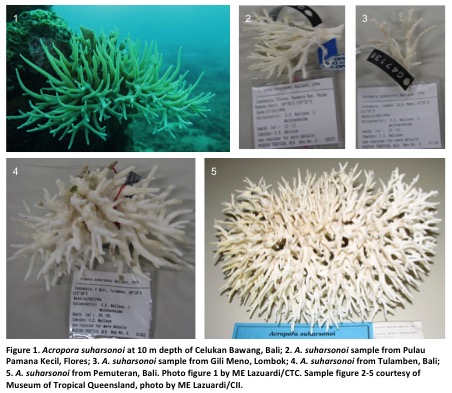“Acropora suharsonoi might be has a wider distribution, approximately around Lesser Sunda Islands, instead of only Bali and Lombok Islands.”
By Muhammad Erdi Lazuardi
Acropora suharsonoi has always been one of the beautiful stony corals in my head. I have been obsessed to find it in the wild since I learned coral identification in 1997. Another reason is because it is named after Indonesian corals lead scientist: Prof. Suharsono.
In the beginning I only saw it in some coral books. Afterward, I have an opportunity to join a short course of coral taxonomy in the Museum of Tropical Queensland (MTQ) in 2008 where a massive collection of hard corals around the world is kept. There are 400,000 specimens stored in their building, including A. suharsonoi specimens. Finally in 2015 I found it in the wild.
The appearance of this species is a stark contrast to most other Acropora corals, in that the branches appear bare due to few or no radial corallites being present (usually less than 5 to a branch) (Wallace, 1999). It was described as a new species by Dr. Carden Wallace in 1994.
Veron (2000) mentions that A. suharsonoi is endemic in Bali and Lombok of Indonesia. Along with Dr. Veron, Dr. Carden Wallace (1999) of MTQ mentions “this rare and distinctive species has only been found on slopes and walls of fringing reefs in Bali and Lombok.” However, I saw several specimens in MTQ that came not only from Bali and Lombok, but Flores too (Pulau Pamana Kecil of Maumere Bay). Therefore, this species can be assumed to have a wider distribution, approximately around Lesser Sunda Islands, instead of only Bali and Lombok Islands. Although the reference on the distribution of this coral is limited, I agree that this coral is very rare.
Moreover, Dr. Wallace says the rarity of A. suharsonoi may perhaps be a reflection of its potentially limited reproductive output caused by the lack of radial corallites. By this rarity in its distribution and abundance, the International Union for Conservation of Nature (IUCN) Redlist places A. suharsonoi status as endangered (Aeby, Lovell, Richards, Delbeek, Reboton & Bass, 2008). According to CITES, all corals species are listed on the CITES Appendix II. However, this species should be prohibited for trading.
IUCN assessed this species as having a low resistance and resilience to climate change impacts, such as coral bleaching events. However, it is very surprising when I found it in North of Bali recently (6 August 2015), even though this area has suffer with coral bleaching event in 2010. In addition, a friend of mine saw A. suharsonoi in several locations of north Bali such as Tejakula, Pemuteran and Patas. Even though I found only one colony and just at 10 m depth (usually it found at 15 to 25 m depth) in Celukan Bawang. This was my first time to see it in the wild and would be happy if I can see again in other places.
It is very impressive that my country has this endemic coral, especially as it is named after Indonesian lead coral scientist, Prof. Suharsono. Studies of distribution, abundance and ecology of Acropora suharsonoi are needed to support Indonesian government in issuing a national status and conservation action plan on the management of its habitat, along with other endemic corals or locally named corals such as Euphyllia baliensis, Acropora togianensis, Acropora derawanensis, Acropora sukaronoi, Acropora batunai, Acropora desalwii, Acropora indonesia, Lithopyllon mokai, Astreopora cendrawasih, Astreopora acroporina and Astreopora montiporina.

Acknowledgement
I acknowledge Fisheries Diving Club – Bogor Agricultural University (FDC-IPB) for scientific diving skills, and many thanks to Conservation International Indonesia, Coral Triangle Center and The Nature Conservancy for experience and join in many marine surveys. I thank to Dr. Lyndon Devantier and Dr. Emre Turak for coral taxonomy knowledge as well as reviewing the article. I thank to Dr. Carden Wallace and Museum of Tropical Queensland for coral taxonomy knowledge. I thank to Jenny Kharmy for reviewing my article. Finally I thank to Derta Prabuning from Reef Check Indonesia and Yunaldi Yahya from LINI for sharing information about A. suharsonoi.
References
Aeby, G., Lovell, E., Richards, Z., Delbeek, J.C., Reboton, C. & Bass, D. (2008). Acropora suharsonoi. The IUCN Red List of Threatened Species 2008: e.T133254A3656302. http://dx.doi.org/10.2305/IUCN.UK.2008.RLTS.T133254A3656302.en. Downloaded on 03 February 2016.
Veron, J.E.N. (2000). Corals of the world. Vol 1-3. M. Stanford-Smith (Ed). Townsville: Australian Institute of Marine Science. 1382 p.
Wallace, C.C. (1999). Staghorn corals of the world. A revision of the genus Acropora (Scleractinia ; Astrocoeniina ; Acroporidae) worldwide, with emphasis on morphology, phylogeny and biogeography. Collingwood, Vic: CSIRO. 438 p.




















